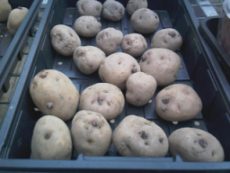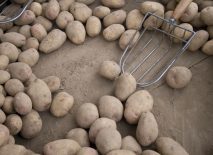
|


|
Grow your Own: PotatoesGrowing potatoes is relatively easy and there's nothing more rewarding than digging them up and searching for all your new potatoes in the soil. However, for a vegetable that is cheap to buy in the shops, they do take up quite a bit of space and they're hungry feeders too. They are known for breaking up the soil and preparing new ground but that's only because you have to dig around a lot to harvest them. They won't grow all that well on ground that isn't properly prepared and fertilised. Choosing your seed potatoesThe terms first earlies, second earlies and main crops are confusing to a lot of people but they simply refer to the amount of time it takes before you can harvest your potatoes. First and second earlies are ready to harvest in a shorter space of time than the maincrops - between 10 weeks and 13 weeks depending on the type. They are generally designed to be eaten more or less as you harvest them. Maincrops and late maincrops take between 15 and 20 weeks and produce a better yield. These varieties can be stored for use over winter. Apart from that, its all about what variety you prefer and this is really just a question of trial and error. Preparing for planting
First you need to chit your potatoes. Chitting is the term used for encouraging potatoes to sprout before planting which produces a better crop. To chit potatoes, place the potatoes side by side, making sure they don't touch, in a tray and leave in a light, dry place indoors. In four or five weeks, the eyes of the potatoes will have produced shoots and they are ready to plant out. To ensure potatoes don't touch, you can place them in egg cartons. While you wait for your seed potatoes to sprout, you can go ahead and prepare the ground. Dig it over well and remove any weeds. Add a good amount of manure or compost to the soil. You get a better result from potatoes if you plant them in trenches and this allows you to concentrate the compost or fertiliser in the trench. If you can get a hold of it, your potatoes will appreciate a generous helping of washed seaweed. Some Ayrshire potato farmers spread seaweed on their land - it doesn't smell too great on a warm day but it seems to work. If you don't have space for a potato patch, you can grow potatoes in just about any container as long as its deep enough. All you really need is a plastic bag like the kind used to hold potting compost, with some holes pierced in the bottom for drainage. Use a mixture of garden soil and compost. Growing them in a bag makes it a whole lot easier to harvest as you simply tip them out of the bag when they're ready. Growing
Plant your potatoes in their prepared trenches and cover with a good layer of soil. You'll get a better crop if you earth them up from time to time. This simply means drawing the soil over the base of the above-ground shoots until you end up with an inverted trench. Earthing up helps protect your potatoes from late frosts and stops the top of the potatoes from turning green in the sunlight. Pests and DiseasesThe two biggest enemies of the potato grower is wireworm and potato blight. Wireworm is the larvae of the click beetle and is responsible for those little holes you sometimes see in bought potatoes. Potato blight is a fungal disease famously responsible for the Irish potato famine. It is carried on the air in warm, humid conditions but may also be present in the soil on unharvested potatoes from previous years. The best treatment for both wireworm and potato blight is prevention. Rotating your crops will help. This means you shouldn't follow a potato crop in the previous year with a potato or any other root crop in the following year. That way you will prevent wireworm numbers from getting out of control and avoid the spread of potato blight from the previous year's crop. You can also buy blight resistant varieties of potatoes. Harvesting
StoringPotatoes must be stored in the dark and in a frost-free environment but not too warm a place either. You can store them in a hessian sack or in a box covered with sterile soil or wrapped in a dark-coloured sheet and a shed would be the best place to house them. Don't store them in a plastic bag because you don't want moisture to collect inside the bag. You might also want to read...
Home
Contact
Submit a Site
Syndication
Write for Us
Back Copy
RSS Feed
|
|
 Your potatoes are ready when the flowers die off and your early variety will be the first. Use a fork to lift them so that you can avoid damaging the potatoes. If they're ready, your potatoes should simply drop away from the plant as you lift them. Potato tops (haulms) can be added to your compost bin.
Your potatoes are ready when the flowers die off and your early variety will be the first. Use a fork to lift them so that you can avoid damaging the potatoes. If they're ready, your potatoes should simply drop away from the plant as you lift them. Potato tops (haulms) can be added to your compost bin.


